 |
 |
Anatomy of a Bill: The Printed Elements
Intaglio Printing
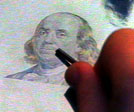 Intaglio printing is what gives the U.S. currency its distinctive look. The
process begins with an engraving, both of the portrait and of the fine line
detail surrounding the bill. This beautiful art is painstakingly produced by a
master engraver on steel plates. These master plates form the actual
production plates used during the printing process. A high-viscosity ink is
then applied to the plates, and the printing process begins. The plates are
first wiped clean, leaving only ink in the grooves, then pressed with enormous
pressure (7,500 to 15,000 psi) which transfers the ink to the paper. The
enormous pressure causes the paper to be embossed with the ink, Intaglio printing is what gives the U.S. currency its distinctive look. The
process begins with an engraving, both of the portrait and of the fine line
detail surrounding the bill. This beautiful art is painstakingly produced by a
master engraver on steel plates. These master plates form the actual
production plates used during the printing process. A high-viscosity ink is
then applied to the plates, and the printing process begins. The plates are
first wiped clean, leaving only ink in the grooves, then pressed with enormous
pressure (7,500 to 15,000 psi) which transfers the ink to the paper. The
enormous pressure causes the paper to be embossed with the ink, 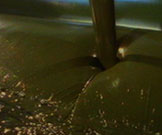 thus giving the
ink a distinctive raised feel that other printing techniques cannot duplicate.
The very fine engravings appear
muddy when reproduced in counterfeit notes. While most of the front and back part of the bill
is produced in this way, the Treasury seal, Federal Reserve seal and serial
numbers are not printed with the Intaglio process. thus giving the
ink a distinctive raised feel that other printing techniques cannot duplicate.
The very fine engravings appear
muddy when reproduced in counterfeit notes. While most of the front and back part of the bill
is produced in this way, the Treasury seal, Federal Reserve seal and serial
numbers are not printed with the Intaglio process.
Portrait
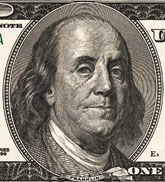 The portrait may not seem to be a security feature, but the Treasury maintains
that the face is the most recognizable part of money. People will tend to
remember faces, and if the bill is counterfeit, they will see that the face is
not exactly right. As people already associated Ben Franklin with the $100
bill, the Treasury did not want to change the face on the bill. While the
faces on some foreign currency change as the countries political climate
changes, the U.S wanted to present an image of stability. Instead, they
decided to enlarge the portrait on the new $100. The portrait was
painstakingly engraved by Thomas Hipschen, and the Treasury hopes the new
enlarged details will make counterfeit bills stand out more clearly from the
real thing. By moving the portrait to the left, the face will suffer less wear
from folding. The move also makes extra room for the watermark on the right
side. The portrait may not seem to be a security feature, but the Treasury maintains
that the face is the most recognizable part of money. People will tend to
remember faces, and if the bill is counterfeit, they will see that the face is
not exactly right. As people already associated Ben Franklin with the $100
bill, the Treasury did not want to change the face on the bill. While the
faces on some foreign currency change as the countries political climate
changes, the U.S wanted to present an image of stability. Instead, they
decided to enlarge the portrait on the new $100. The portrait was
painstakingly engraved by Thomas Hipschen, and the Treasury hopes the new
enlarged details will make counterfeit bills stand out more clearly from the
real thing. By moving the portrait to the left, the face will suffer less wear
from folding. The move also makes extra room for the watermark on the right
side.
Color Shifting Ink
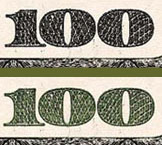 Perhaps the most "high-tech" of the new security features, the black to green
color-shifting is a new and important element of the redesigned $100 bill.
Similar types of ink have already been used on some foreign currency and on the
newest U.S. passports. The change in color is the result of
multi-layered metallic flakes added to the ink. When the bill is tilted, light
reflects off these flakes at different wavelengths and changes colors. This
is called color diffraction, which is also responsible for the color variations
found on the wings of some butterflies. Because this special combination of
materials and ink is sold exclusively to the United States government, the
Treasury is hopeful that this will be one feature that will be extremely difficult to
counterfeit. Perhaps the most "high-tech" of the new security features, the black to green
color-shifting is a new and important element of the redesigned $100 bill.
Similar types of ink have already been used on some foreign currency and on the
newest U.S. passports. The change in color is the result of
multi-layered metallic flakes added to the ink. When the bill is tilted, light
reflects off these flakes at different wavelengths and changes colors. This
is called color diffraction, which is also responsible for the color variations
found on the wings of some butterflies. Because this special combination of
materials and ink is sold exclusively to the United States government, the
Treasury is hopeful that this will be one feature that will be extremely difficult to
counterfeit.
Microprinting
 Microprinting appears as just a thin line to the naked eye, but can be easily
read upon magnification. The introduction of microprinting in 1990 began with
the addition of the words "The United States of America" printed around the
edge of the portraits. The new bills still use microprinting, but in a different
location. These words now appear around Ben Franklin's lapel. In addition,
the words "USA 100" are printed within the lower left "100." Microprinting is
very difficult to reproduce accurately on photocopiers because most copiers do
not have the ability to work at such high resolution. This situation may not last long,
however, as improved scanning devices are now able to print at this fine
detailed level. The Treasury hopes the combination of the many
anti-replication features will help deter potential counterfeiters. Microprinting appears as just a thin line to the naked eye, but can be easily
read upon magnification. The introduction of microprinting in 1990 began with
the addition of the words "The United States of America" printed around the
edge of the portraits. The new bills still use microprinting, but in a different
location. These words now appear around Ben Franklin's lapel. In addition,
the words "USA 100" are printed within the lower left "100." Microprinting is
very difficult to reproduce accurately on photocopiers because most copiers do
not have the ability to work at such high resolution. This situation may not last long,
however, as improved scanning devices are now able to print at this fine
detailed level. The Treasury hopes the combination of the many
anti-replication features will help deter potential counterfeiters.
Fine Line Engraving

Fine circular lines appear around the portrait of the bill. The
clarity and detail of these lines are difficult for scanners and photocopiers
to reproduce. These lines often cause a blur, or moiré, during the
scanning process.
Serial Numbers and Treasury Seal
 The serial number is especially important for banks which handle large amounts
of cash. No two serial numbers are the same. On the new bills, these serial
numbers have been increased to 11 digits. In addition, the new bills contain a
redesigned The serial number is especially important for banks which handle large amounts
of cash. No two serial numbers are the same. On the new bills, these serial
numbers have been increased to 11 digits. In addition, the new bills contain a
redesigned 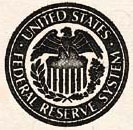 Federal Reserve seal and code which indicate the bill's issuing
bank. While the old bills contain this information, on the new bills the
numbers are clearer and easier to identify. The old green Treasury seal hidden
behind the "100" has long been part of U.S currency and will remain an
important security feature. This detailed combination of green and black is
difficult to reproduce. Like all overt features, however, the new bills will
require continuous upgrades and additions as new technology arises that makes the
features more vulnerable. Federal Reserve seal and code which indicate the bill's issuing
bank. While the old bills contain this information, on the new bills the
numbers are clearer and easier to identify. The old green Treasury seal hidden
behind the "100" has long been part of U.S currency and will remain an
important security feature. This detailed combination of green and black is
difficult to reproduce. Like all overt features, however, the new bills will
require continuous upgrades and additions as new technology arises that makes the
features more vulnerable.
Anatomy of a Bill: The Currency Paper
Anatomy of a Bill |
History of Money |
Digital Cash
Bogus Bill |
Resources |
Update to Program |
Teacher's Guide
Transcript |
Site Map |
Secrets of Making Money Home
Editor's Picks |
Previous Sites |
Join Us/E-mail |
TV/Web Schedule |
About NOVA
Watch NOVAs online |
Teachers |
Site Map |
Shop |
Search |
To Print
PBS Online |
NOVA Online |
WGBH
© | Updated August 2002
|
|
|